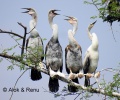m (Text replacement - "''\[\[Media:[^\|]+\|Listen in an external program\]\]''\<br ?\/?\>" to "") |
(→External Links: Additional GSearch for common name. GSearch Checked template) |
||
| Line 43: | Line 43: | ||
{{ref}} | {{ref}} | ||
==External Links== | ==External Links== | ||
| + | Search the Gallery using the scientific name: | ||
{{GSearch|Anhinga+melanogaster}} | {{GSearch|Anhinga+melanogaster}} | ||
| + | Search the Gallery using the common name: | ||
| + | {{GSearch|"Oriental Darter"}} | ||
| + | {{GS-checked}} | ||
<br /> | <br /> | ||
| − | + | <br /> | |
| − | [[Category:Birds]] [[Category:Anhinga | + | |
| + | [[Category:Birds]] [[Category:Anhinga]] [[Category:Bird Songs]] | ||
Revision as of 19:27, 18 May 2022
Alternative name: Snakebird
- Anhinga melanogaster
Identification
85–97 cm (33½-38¼ in); A tall cormorant-like species
- Very long neck
- White lateral neck stripe
Male
- Glossy black overall plumage with white streaks
Females and immature birds are browner.
Similar species
African Darter and Australasian Darter
Distribution
From Iraq east to Pakistan, India and to south-eastern Asia, Malay Archipelago and Philippine Islands.
Taxonomy
This is a monotypic species.
It was formerly lumped with African Darter and Australasian Darter.
Habitat
Clean, shallow water in lakes, fresh and alkaline; and big rivers.
Behaviour
Often swims with only the neck above water.
Diet

They spear their prey underwater (mainly fish but also other aquatic animals e.g. water snakes, frogs, crustaceans etc.) as they swim.
Breeding
They construct a stick nest in a tree; the clutch consists of 3-6 eggs. They often nest with herons, egrets and cormorants.
Vocalisation
Recording by Alok Tewari
Keoladeo National Park, India, Dec-2015
An individual sitting on a dry branch, in front, called twice as we were trying to capture perfect sunset.
Gallery
Click images to see larger version
Fledglings
© by Alok Tewari
Keoladeo National Park, Bharatpur, India, September-2018
References
- Clements, J. F., T. S. Schulenberg, M. J. Iliff, D. Roberson, T. A. Fredericks, B. L. Sullivan, and C. L. Wood. 2018. The eBird/Clements checklist of birds of the world: v2018. Downloaded from http://www.birds.cornell.edu/clementschecklist/download/
- Handbook of the Birds of the World Alive (retrieved March 2017)
Recommended Citation
- BirdForum Opus contributors. (2024) Oriental Darter. In: BirdForum, the forum for wild birds and birding. Retrieved 25 April 2024 from https://www.birdforum.net/opus/Oriental_Darter
External Links
Search the Gallery using the scientific name:
Search the Gallery using the common name:
GSearch checked for 2020 platform.






